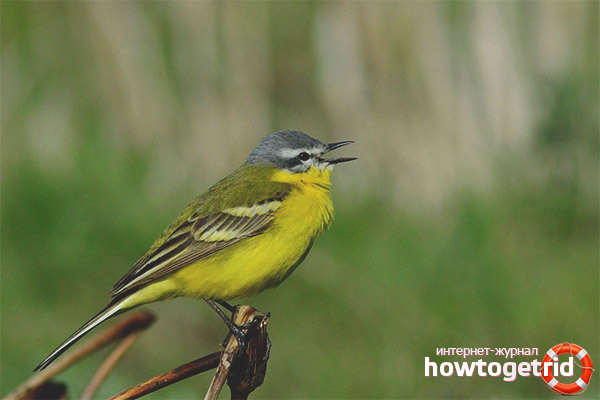The content of the article
The yellow wagtail is considered a family of wagtail, the weight of this small bird does not exceed 17 grams, and the body size of an adult reaches 17 centimeters. The wagtail has a rather long and thin tail that characterizes all representatives of this family. The bird acquired its name due to the peculiar tail shake that it periodically makes.
The lower body of this little bird is yellow in color, and on the back it has a gray-olive plumage. White stripes are clearly distinguishable on its dark brown wings; white stripes also stand out on the black tail of the wagtail.
A gray, sometimes black zone is formed on the head of an adult male, resembling a hat in its appearance. Females of these birds also have similar formations on their heads, only unlike males it has a brownish-gray hue and rather blurry contours. The legs, like the beak of these birds, are painted black. Young individuals of yellow wagtails have plumage painted in a brownish-gray tone.
Habitat
By and large, the yellow wagtail is a migratory bird; only in a few southern regions does it choose a settled life. You can meet this bird in various lowlands, on which there are forests or forest-steppe strips, it is also attracted by swampy meadows or river valleys. A marshland with grass cover and sparse shrubs is also suitable for it as a habitat.
But in the taiga wagtail is practically not found, only coasts of forest rivers can be an exception. This bird does not observe clear conditions of settlement, it is capable of both solitary form and group meetings.
Offspring
A yellow wagtail hurries to its nesting sites right after the snow melts and the first green appears. Much depends on latitude here, in the middle zone it is expected to appear in the second half of April, and in Siberia it cannot be seen before the beginning of May.
A prerequisite for the settlement of these birds is direct proximity to various water bodies. It can easily be flooded meadows of the coast of lakes and various rivers. Wetlands with sparse shrubs also attract the attention of wagtails. The place for the device of the nest must meet many requirements, so the birds do not spare time for his choice, spending several days in search.
The male does not take part in hatching masonry and in the device of the nest, all this time he is nearby on a convenient hill, guarding the territory from the invasion of the enemy. When the female sits on the masonry, the male provides her with food.
These birds arrange a nest right on the ground, finding a suitable recess, under the cover of a hummock, lonely bush or tall grass. When a threat occurs, which is most often crows, as well as dogs and even humans, the bird exhibits rather restless behavior. The male takes off and screams trying to distract the attention of an uninvited guest, and the female at this time retreats under the cover of grass up to 20 meters, then takes off and, returning, joins the actions of the male.In the event of the frequent appearance of uninvited guests, she can easily leave the nest.
The nest of the wagtail has the shape of a shallow bowl, the material for its construction is small twigs, various leaves, dry grass stems and root fragments. For litter nests, these birds use hair mixed with wool. In the laying of the female there are about 5 eggs that have a yellowish, sometimes greenish, tint with frequent interspersed gray, less often brown.
The wagtail hatching its clutch for about 13 days, the chicks grow up for only two weeks. Both parents are engaged in feeding the offspring, and for some time they also take care of their offspring, who recently left the nest, because at first the young wagtails cannot get their own food. In rare cases, they manage to feed two broods in one season.
Diet

Birds of this species in their manner of behavior are very similar to white wagtails, and differ from them in that yellow wagtails are sought after on the ground, while white wagtons do this in the air. In search of their prey, these birds flutter close to the ground and, having descended, move rather adroitly on it.
Having discovered its prey, the wagtail begins to pursue only one of it, without being distracted by the other temptations. Upon successful completion of the chase, the victim is immediately swallowed. This bird will never allow the pursuit of “two hares,” apparently, she knows what this leads to. In the case when there is not enough food in the nesting territory, the yellow wagtail is ready to challenge its rights with its closest neighbors.
At the end of summer, rested adults and young animals begin small migrations to wetlands, and from the second decade of August to mid-October they go on a seasonal flight. These birds are preferred for wintering in the southern regions of Asia or in Africa, and can also go to the Malay Islands, some even to the coast of the Philippines.
Video: Yellow Wagtail (Motacilla flava)











Submit